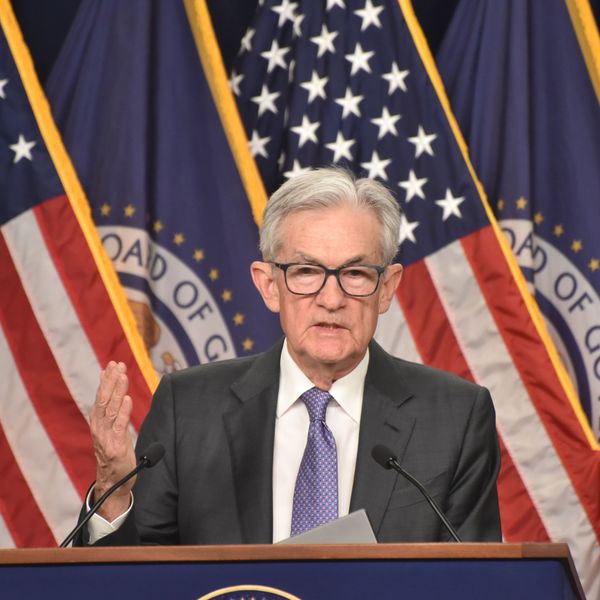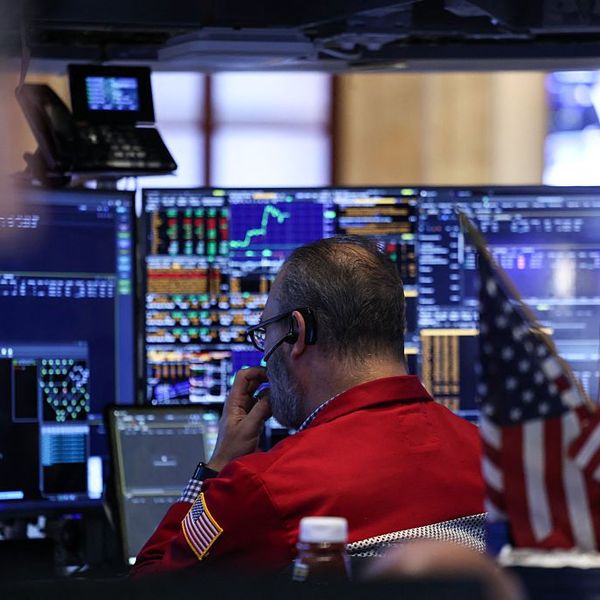
U.S. Federal Reserve Bank Board Chairman Jerome Powell answers reporters' questions during a news conference in Washington, D.C. on November 2, 2022.
Friday's Surprisingly Positive Jobs Report Does Not Mean Fed Should Keep Raising Rates
The basic reality is American workers don’t have the power to raise their wages. Big American corporations have the power to raise their prices.
Surprising most analysts and forecasters, employers added a whopping 517,000 jobs in January, according to Friday morning’s monthly labor report from the Bureau of Labor Statistics. This was almost twice the growth from December’s 260,000 jobs. The unemployment rate fell to 3.4 percent, the lowest since 1969.
What does this mean?
It may mean very little. The Bureau of Labor Statistics’s monthly report can bounce around a lot, depending on seasonal weights and samples. Next month’s job number could be far lower.
Also, keep your eye on wage growth. Average hourly earnings climbed in January at a slower pace than in December — by an annualized 4.4 percent, down from 4.8 percent in December. With prices still rising faster than wages, most workers continue to suffer declining real wage – that is, declining purchasing power.
But the strength of the labor market is likely to worry the Fed, which last Wednesday raised interest rates for the eighth time in a year – although only by a quarter of a percentage point this time.
“The labor market continues to be out of balance,” Jerome Powell, the Fed chair, said earlier this week. He stressed that we won’t have a return to his target 2 percent inflation in the service sector “without a better balance in the labor market,” adding “I don’t know what that will require in terms of increased unemployment.”
As I’ve said many times over the past year, this worry is misplaced. Most of the upward pressure on prices domestically is coming from big corporations with the market power to raise prices faster than their costs are rising. Much of the rest is coming from continuing supply shocks abroad, including Putin’s war’s effects on global energy and food prices, and China’s lockdowns followed by COVID.
And, as Friday’s report shows, wage gains are slowing and they lag behind price increases.
The basic reality is American workers don’t have the power to raise their wages. Big American corporations have the power to raise their prices. The Fed should not be aiming to increase unemployment as a means of slowing prices.
An Urgent Message From Our Co-Founder
Dear Common Dreams reader, The U.S. is on a fast track to authoritarianism like nothing I've ever seen. Meanwhile, corporate news outlets are utterly capitulating to Trump, twisting their coverage to avoid drawing his ire while lining up to stuff cash in his pockets. That's why I believe that Common Dreams is doing the best and most consequential reporting that we've ever done. Our small but mighty team is a progressive reporting powerhouse, covering the news every day that the corporate media never will. Our mission has always been simple: To inform. To inspire. And to ignite change for the common good. Now here's the key piece that I want all our readers to understand: None of this would be possible without your financial support. That's not just some fundraising cliche. It's the absolute and literal truth. We don't accept corporate advertising and never will. We don't have a paywall because we don't think people should be blocked from critical news based on their ability to pay. Everything we do is funded by the donations of readers like you. Will you donate now to help power the nonprofit, independent reporting of Common Dreams? Thank you for being a vital member of our community. Together, we can keep independent journalism alive when it’s needed most. - Craig Brown, Co-founder |
Surprising most analysts and forecasters, employers added a whopping 517,000 jobs in January, according to Friday morning’s monthly labor report from the Bureau of Labor Statistics. This was almost twice the growth from December’s 260,000 jobs. The unemployment rate fell to 3.4 percent, the lowest since 1969.
What does this mean?
It may mean very little. The Bureau of Labor Statistics’s monthly report can bounce around a lot, depending on seasonal weights and samples. Next month’s job number could be far lower.
Also, keep your eye on wage growth. Average hourly earnings climbed in January at a slower pace than in December — by an annualized 4.4 percent, down from 4.8 percent in December. With prices still rising faster than wages, most workers continue to suffer declining real wage – that is, declining purchasing power.
But the strength of the labor market is likely to worry the Fed, which last Wednesday raised interest rates for the eighth time in a year – although only by a quarter of a percentage point this time.
“The labor market continues to be out of balance,” Jerome Powell, the Fed chair, said earlier this week. He stressed that we won’t have a return to his target 2 percent inflation in the service sector “without a better balance in the labor market,” adding “I don’t know what that will require in terms of increased unemployment.”
As I’ve said many times over the past year, this worry is misplaced. Most of the upward pressure on prices domestically is coming from big corporations with the market power to raise prices faster than their costs are rising. Much of the rest is coming from continuing supply shocks abroad, including Putin’s war’s effects on global energy and food prices, and China’s lockdowns followed by COVID.
And, as Friday’s report shows, wage gains are slowing and they lag behind price increases.
The basic reality is American workers don’t have the power to raise their wages. Big American corporations have the power to raise their prices. The Fed should not be aiming to increase unemployment as a means of slowing prices.
- 'People Will Lose Their Jobs': Expert Chorus Against Fed Rate Hikes Grows ›
- 'Bad News for Workers' as Wage Growth Slows Amid Fed Rate Hike Barrage ›
Surprising most analysts and forecasters, employers added a whopping 517,000 jobs in January, according to Friday morning’s monthly labor report from the Bureau of Labor Statistics. This was almost twice the growth from December’s 260,000 jobs. The unemployment rate fell to 3.4 percent, the lowest since 1969.
What does this mean?
It may mean very little. The Bureau of Labor Statistics’s monthly report can bounce around a lot, depending on seasonal weights and samples. Next month’s job number could be far lower.
Also, keep your eye on wage growth. Average hourly earnings climbed in January at a slower pace than in December — by an annualized 4.4 percent, down from 4.8 percent in December. With prices still rising faster than wages, most workers continue to suffer declining real wage – that is, declining purchasing power.
But the strength of the labor market is likely to worry the Fed, which last Wednesday raised interest rates for the eighth time in a year – although only by a quarter of a percentage point this time.
“The labor market continues to be out of balance,” Jerome Powell, the Fed chair, said earlier this week. He stressed that we won’t have a return to his target 2 percent inflation in the service sector “without a better balance in the labor market,” adding “I don’t know what that will require in terms of increased unemployment.”
As I’ve said many times over the past year, this worry is misplaced. Most of the upward pressure on prices domestically is coming from big corporations with the market power to raise prices faster than their costs are rising. Much of the rest is coming from continuing supply shocks abroad, including Putin’s war’s effects on global energy and food prices, and China’s lockdowns followed by COVID.
And, as Friday’s report shows, wage gains are slowing and they lag behind price increases.
The basic reality is American workers don’t have the power to raise their wages. Big American corporations have the power to raise their prices. The Fed should not be aiming to increase unemployment as a means of slowing prices.
- 'People Will Lose Their Jobs': Expert Chorus Against Fed Rate Hikes Grows ›
- 'Bad News for Workers' as Wage Growth Slows Amid Fed Rate Hike Barrage ›

